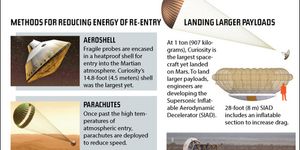We've all heard about plans for exploring and possibly even colonizing Mars. To do that we'll have to land a lot of hardware there: habitats, vehicles, supplies. But if you're landing something the size of a building, or a large truck on the surface of Mars, how do you get it down safely? NASA is testing a new saucer-shaped vehicle that will help them do just that.

The Low-Density Supersonic Decelerator (LDSD) test vehicle - which NASA has dubbed the "flying saucer" is an inflatable heat shield and atmospheric brake. They are essentially a system of inflatable concentric rings designed to fit around the rim of an entry vehicle. They are designed to inflate as a craft enters the atmosphere of its target planet. Once inflated, they will increase the surface area of the vehicle and thereby increase atmospheric drag, slowing down the vehicle.
Most heat shields up to this point have been rigid. NASA officials hope this new inflatable system will vastly increase the size and weight of the payloads the agency can land safely on Mars. The "sky crane" system that help get the Curiosity lander safely down on Mars used in August 2012 is capable of handling about 1 metric ton. But a manned mission to Mars will require elements that are more in the range of 10 to 20 metric tons.
Last Tuesday NASA engineers put the LDSD through initial testing in preparation for flight testing this June. They subjected the "Flying Saucer" to a "spin table" test at NASA's Jet Propulsion Laboratory (JPL) in Pasadena, California. Engineers were looking for any wobbles caused by any less than perfect distribution of mass throughout the 7,000-lb. (3,175 kilogram) 15-foot (4.6 meter)-wide vehicle. Any wobbles the team found were corrected by attaching small weights at the appropriate spots around the craft's rim. Sound familiar? Well, "This is like spinning your automobile tire, and putting weights on it to make sure that it spins perfectly," says JPL's LDSD Chief Engineer Rob Manning.
Another part of the LDSD project is the development of a 100-foot (31 m) -wide supersonic parachute. This will be the biggest chute of its kind ever made. Just for comparison, when NASA's Mars Curiosity rover was landing, it used a 51-foot (15.5 m) -wide parachute. This is the sort of parachute that will be needed for the much bigger, much heavier loads NASA intents to put down on the red planet during a manned mission.
The next step for the LDSD vehicle will be shipment to Hawaii, for its second round of flight testing at the U.S. Navy's Pacific Missile Range Facility on the island of Kauai. This second round of testing is scheduled to take place between June 2 and June 12, weather permitting.
The first round of flight testing for the "flying saucer" took place last June at the same Hawaii facility. During that round of testing the vehicle was carried by a huge balloon up to an altitude of 23 miles (37 kilometers), which is a good analog for the thin Martian atmosphere. There the craft was dropped and its onboard rocket motor boosted it to Mach 4 (four times the speed of sound) and an altitude of 34 miles (55 km). Aside from ripping its parachute, the craft performed perfectly. The ripped parachute was exactly the kind of data the test was looking for, and allowed NASA specialists to re-engineer the parachute out of much stronger material.
(Source: Space.com)









